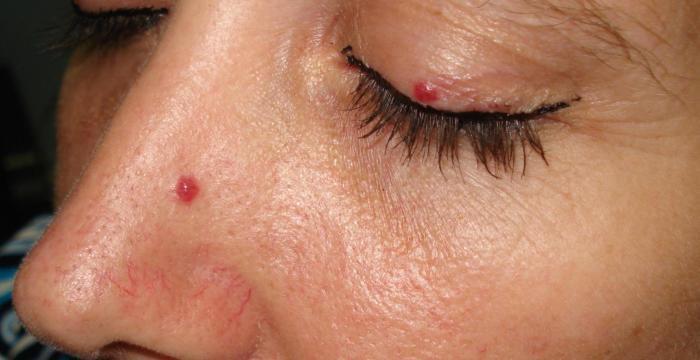What is angioma: types, treatments, results, side effects & FAQs
Cherry Angioma: types, treatments, results, side effects
What Is a Cherry Angioma?
Introduction
At least two out of every 100 children have angiomas. In the vast majority of cases, the size is progressively reduced during the first year of life. It eventually tends to shrink to half its original size at 5-6 years of age. When the child reaches ten years of age, it may disappear altogether.
What is angioma?
Below we will describe the most common types of angioma in children:
- Simple angioma: This type of lesion does not go away over time. Although with time, they tend to diminish their dark red colour to a paler one. They can occur from birth in any part of the body, and the most important thing is that they do not cause secondary problems.
- Flat angioma: Like simple angioma, these do not present any complications and tend to disappear over time. Its most frequent location is the head (eyelids and neck).
- Childhood hemangioma: As mentioned above, they can be observed from the second month of life and manifest in any body part. Mainly head, neck, and trunk. These tend to disappear over the years and do not require additional treatment if they are not compromising any vital part of the body, such as the eyes or respiratory tract.
Most common types of hemangiomas in adults:
- Capillary hemangioma, Campbell de Morgan spots, or senile angioma (also known as ruby spots, cherry hemangiomas, or cherry angiomas): This type is small and very superficial on the skin. It appears with age, mainly on the neck and head.
- Cavernous hemangioma: This lesion is purple or bluish. For this reason, it is described as “nevo in flames.” Unlike the previous ones, it is found in deeper areas of the skin.
How do I find my doctor?
t or by a surgeon to remove the lesion. In some cases, more specialized doctors will be needed depending on the location of the mass, for example, near the eye (ophthalmologist) or in the mouth (maxillofacial surgeon) or an angiologist surgeon for other parts of the body. It is necessary to remember that most cases reduce in size over time, so it will only be necessary to frequent check-ups with the paediatrician.
In adults, these lesions do not shrink over time. When the treatment is only cosmetic, you can go to a dermatologist, plastic surgeon, or angiologist. They sometimes work together to determine the procedure to follow to achieve an excellent result.
What happens during the first consultation?
When angiomas appear in newborns, paediatricians will monitor them closely from the beginning. At first, it may seem problematic because the lesions tend to increase in size, but they will begin to reduce over the months until they disappear. The doctor will do a complete physical exam and review the other areas of the skin to determine the number and location of the lesions. The American Ophthalmology Association mentions that it will be convenient to assess the patient monthly during the first 6 months of life. Then every 2-3 months until the first year of life to continue every 6 months until 4 years of age.
It is essential to determine that these are not close to sensitive areas of the face such as the eyes, throat, or mouth. When indicated by the doctor, more extensive studies such as CT scans or MRI will be necessary. In some cases, these will be necessary to determine the extent and depth of the injury. Finally, it will be verified that the lesions are not bleeding, with signs of inflammation or infection.
What treatments exist to eliminate them?
Professionals recommend that the treatments be done where the hemangiomas are found and depending on the extension and depth of it. Steroid medicines (corticosteroids) can be used initially. To make the blood vessels reduce their size. Steroids can stop the progression of hemangiomas by causing blood vessels to shrink. Depending on its size and location, steroids can be prescribed orally; they can be injected directly into the lesion or applied topically to the skin in the area where it is located.
The medicine called Propanolol has been included as part of the treatment and can be used instead of steroids. This can also be taken by mouth or applied topically as a cream. When hemangiomas are superficial, a laser can be used. This reduces the size and makes it look with a more natural and clear tone. In some cases, the doctor will recommend surgery.
What are the expected results?
With capillary hemangiomas of infancy, no therapeutic measures will be necessary since their almost total regression is expected. But when they don’t, parents will look for an aesthetic solution to lessen the possible psychosocial impact on the child’s life.
It is essential to mention that over time the affected skin area may be left with a slight reddish colouration, a slightly wrinkled appearance, or even look completely normal will depend on each patient.
When treatment is indicated, the results begin to be noticeable after 15-20 days. We must point out skin redness, swelling of the treated area, and skin peeling among the complications.
Although radiotherapy is one of the most used therapies to reduce these skin lesions, it is important to mention that its effects are obtained after several repeated sessions. On the contrary, when hemangiomas are very large and affect vital structures, your doctor will indicate the specific results and complications of the case.
What are the possible risks and side effects?
Medline describes the most common complications of Angiomas:
- Bleeding (especially if the hemangioma is injured).
- Trouble breathing and eating.
- Psychological problems due to the appearance of the skin.
- Secondary sores and infections.
- Visible changes in the skin.
- Vision problems.
Specialists mention the following about the treatment:
- Treatments remove angiomas effectively.
- They are quick and painless.
- They do not leave a scar.
- Has hardly any side effects.
Frequent questions
- Are angiomas hereditary? Specialists mention that an angioma is a benign tumour that usually occurs relatively frequently in childhood. It is believed to be a developmental defect and is generally hereditary. Angiomas are lesions that tend to remit because after a growth period, there is a stabilization phase, and finally, they disappear in most cases and with almost no sign of their existence. It is advised not to worry about this and enjoy your pregnancy.
- Is it possible to remove a facial hemangioma? Angiomas can be treated with vascular lasers. If it is a flat angioma, the latest generation pulsed dye vascular laser or Intense Pulsed Light is recommended. You can also use the Neodymium: Yag laser. Usually, the aesthetic results are good, but a specialist should evaluate your case.
- How do you know if an angioma will go away on its own, or will it be necessary to use a laser? Usually, in adults, when an angioma appears (vascular dilation), there is no going back because the angiomas do not regress and disappear on their own; the laser is needed to make them disappear. It is a treatment that must be done in several sessions, which depend on the size and vascular pressure of the angioma “.
- Is it possible to remove the scar left after removing an angioma in childhood? It is recommended to receive a personalized diagnosis. In this way, the management to continue to achieve the desired aesthetic effects can be determined.
- Can I have an angioma I have removed for the esthetics? Angiomas can be treated with a vascular laser. If it is a flat angioma, the latest generation pulsed dye vascular laser or Intense Pulsed Light is usually recommended. In the case of angiomas with relief, the Neodymium: Yag laser can also be used.
- Normally the aesthetic results are good, but a specialist should evaluate your case.
- Can a facial hemangioma be removed? The plastic surgeon can remove the facial hemangioma, even at the expense of social security or a private insurance company. It is a congenital malformation, not only an aesthetic problem because over the years, the blood vessels it contains dilate and increase in thickness, in addition to the fact that there is a risk of bleeding due to an accident.




GIPHY App Key not set. Please check settings